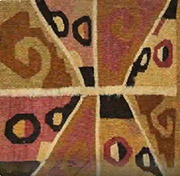Center, Textile Research

IX Jornadas Internacionales de Textiles Precolombinos y Amerindianos / 9th International Conference on PreColumbian and Amerindian Textiles, Museo delle Culture, Milan, 2022
Date of this Version
2024
Document Type
Article
Citation
Published in IX Jornadas Internacionales de Textiles Precolombinos y Amerindianos / 9th International Conference on Pre-Columbian and Amerindian Textiles, Museo delle Culture, Milan, 2022. (Lincoln, Nebraska: Zea Books, 2024)
DOI: 10.32873/unl.dc.zea.1627
Abstract
The Kuna live in the San Blas Archipelago off the coast of Panama. Kuna women make cotton shirts (mola/molakana) using the reverse appliqué technique. They start by superimposing several thin layers of very colourful fabric. A subtle positioning of cuts brings out the colours of the lower layers and creates patterns. Kuna women are inspired by plants and animals in the nature that surrounds them when creating these patterns. They also draw on a repertoire of patterns from everyday objects. These shirts, sewn with pride and a great deal of humour, can tell us a lot about Kuna society. They reflect Amerindian dualism and illustrate shamanic practices. They reproduce the mythological stories that Kuna men tell and comment on during their weekly meetings in the big meeting house (onmaket mega).
Los Kuna viven en el archipiélago de San Blas, frente a la costa de Panamá. Las mujeres confeccionan blusas de algodón (mola/molakana) mediante la técnica de aplicación inversa. Se superponen varias capas finas de tejido muy colorido. Un sutil juego de cortes resalta los colores de las capas inferiores. Para crear los patrones, las mujeres se inspiran en las plantas y los animales de la naturaleza que las rodea. También recurren a un repertorio de patrones de objetos cotidianos. Estas blusas, cosidas con orgullo y mucho humor, nos dicen mucho sobre la sociedad kuna. Reflejan el dualismo amerindio e ilustran las prácticas chamánicas. Reproducen las historias mitológicas que los hombres cuentan y comentan durante las reuniones semanales en la gran casa de reuniones (onmaket mega).
Included in
American Material Culture Commons, Art and Materials Conservation Commons, Fiber, Textile, and Weaving Arts Commons, Indigenous Studies Commons, Latin American History Commons, Museum Studies Commons, Native American Studies Commons, Other History of Art, Architecture, and Archaeology Commons, Other Religion Commons


Comments
Copyright © 2024 Anne-Françoise Martin